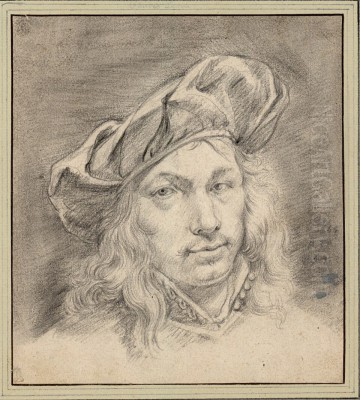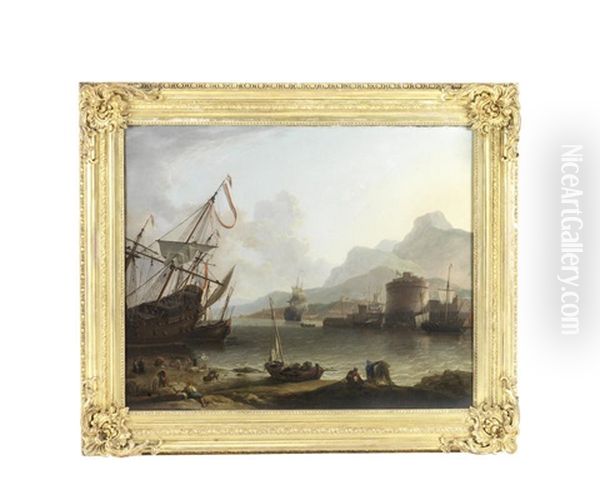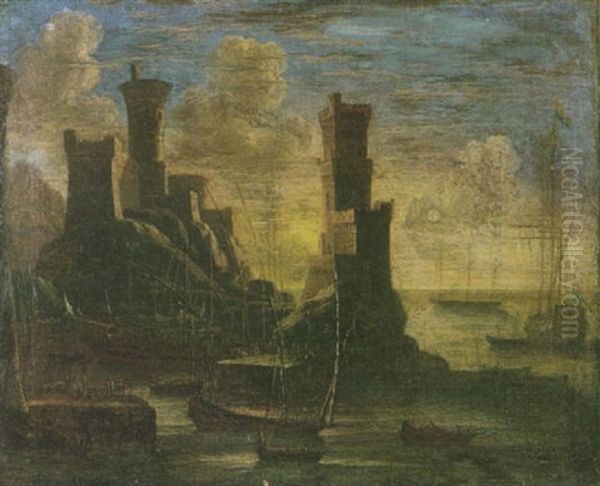
Adriaen van der Cabel stands as a significant figure within the rich tapestry of the Dutch Golden Age of painting. Born around 1631 and living until 1705, his life and career bridged the artistic traditions of Northern Europe with the sun-drenched aesthetics of the Mediterranean, particularly Italy. Primarily celebrated as a landscape painter, he also excelled as a draughtsman and etcher, leaving behind a body of work characterized by its atmospheric depth, detailed observation, and evocative portrayal of harbours, coastal scenes, and pastoral vistas infused with an Italianate sensibility. His journey took him from the Netherlands to the heart of the artistic world in Rome, and finally to Lyon in France, where he settled and continued to produce works that captured the imagination of his contemporaries and continue to be admired today.
Early Life and Artistic Formation in the Netherlands
Adriaen van der Cabel, whose birth name was likely Ariaen Jansz. van der Touw, was born in Rijswijk, a town situated near The Hague and Rotterdam in the Netherlands, around the year 1631. The exact date remains uncertain, a common occurrence for records from this period. His decision to adopt the surname "van der Cabel" later in life is not fully documented but was a practice not entirely unusual for artists seeking a more distinctive professional identity. His formative years as an artist were spent under the tutelage of one of the most influential Dutch landscape painters of the era, Jan van Goyen.

The apprenticeship with Jan van Goyen (1596-1656) was crucial in shaping Van der Cabel's early artistic development. Van Goyen was a master of the "tonal" phase of Dutch landscape painting, known for his subtle monochromatic palettes, low horizons, expansive cloudy skies, and evocative depictions of the Dutch countryside and waterways. He emphasized atmosphere and mood over precise topographical detail. Van der Cabel would have learned the fundamentals of composition, the handling of oil paint, drawing techniques, and perhaps the rudiments of etching within Van Goyen's busy Leiden or The Hague workshop during the late 1640s or early 1650s. Early works attributed to Van der Cabel often reflect this influence, showing a similar interest in atmospheric effects and a relatively subdued colour scheme, though perhaps already hinting at a more robust drawing style.
The Lure of the South: Journey to Italy
Like many Northern European artists of his generation, Van der Cabel felt the powerful pull of Italy. The Italian peninsula, particularly Rome, was considered the ultimate finishing school for ambitious artists. It offered the chance to study classical antiquity firsthand – the ruins, sculptures, and architecture – and to absorb the lessons of the Italian Renaissance and Baroque masters. Furthermore, the Mediterranean light, the dramatic landscapes, and the different quality of life held an exotic appeal compared to the often grey skies and flat terrain of the Netherlands.
Around 1655-1656, Van der Cabel embarked on his journey south. This was a significant undertaking, often made partially on foot or by rudimentary transport, and fraught with potential difficulties. The exact route is unknown, but artists often travelled through Germany or France. His destination was Rome, the vibrant centre of the European art world, teeming with artists from across the continent, all seeking inspiration, patronage, and fame. He likely arrived in Rome by 1656, ready to immerse himself in its artistic milieu.
Roman Years and Artistic Transformation
Van der Cabel's time in Rome, which lasted approximately from 1656 to 1666, proved transformative for his art. He actively engaged with the city's artistic community, which included not only native Italians but also a large contingent of Northern artists, known collectively as the "Bentvueghels" (Birds of a Feather), a society known for its bohemian rituals as much as its artistic exchange. While it's not definitively confirmed if Van der Cabel formally joined the Bentvueghels, he certainly moved within these circles.
Crucially, he encountered the work of prominent Italian and Italianate landscape painters. Art historians note the influence of figures such as Agostino Tassi (c. 1578-1644), known for his illusionistic frescoes and harbour scenes; Pietro Francesco Mola (1612-1666), who often incorporated biblical or mythological figures into rich landscapes; Gaspar Dughet (1615-1675), Nicolas Poussin's brother-in-law and a master of the idealized classical landscape; and the famously tempestuous Salvator Rosa (1615-1673), celebrated for his wild, romantic, and often rugged landscapes populated by bandits or hermits. Contact with these diverse styles broadened Van der Cabel's artistic horizons significantly.

During his Roman period, Van der Cabel's style underwent a marked evolution. While retaining a Dutch sensitivity to detail and texture, he embraced the warmer light and clearer atmosphere of Italy. His palette brightened, moving away from the tonalism of Van Goyen towards more varied and sometimes richer colours. His compositions often became more complex, incorporating classical ruins, picturesque Italian buildings, and the distinctive umbrella pines and cypresses of the region. He developed a particular fondness for coastal and harbour scenes, subjects that allowed him to combine landscape, architecture, water, and lively human activity. This fusion of Northern observational detail with Southern light and motifs became the hallmark of his mature Italianate style.
Settling in Lyon: A Hub Between North and South
After roughly a decade in Rome, Van der Cabel decided to move on. Around 1666, he travelled northwards, heading towards France. It was during this journey, possibly near Turin or on the road to Lyon, that he is documented as meeting fellow artists Peter van Bloemen (1657-1720), known as "Standaart," a painter of battles, camps, and horse markets, and Gillis Wenix (or Weenix, dates uncertain but active late 17th century). Such encounters were common among travelling artists, providing companionship and opportunities for exchange.
Van der Cabel chose to settle in Lyon, a major city in eastern France situated strategically on the Rhône river. Lyon was a significant commercial and cultural centre, potentially offering more stable patronage opportunities than the highly competitive Roman scene. It also served as a natural stopping point for travellers between Italy and Northern Europe. Sources suggest he may have associated with Jacob van Bunnik (brother of the painter Jan van Bunnik, 1654-1727) while in Lyon. It was here, in Lyon, around 1668 or 1669, that Adriaen van der Cabel married Catherine de Gâtinois. He would remain based in Lyon for the rest of his life, becoming a respected member of the local artistic community. He passed away in Lyon and was buried on June 16, 1705.
The Mature Artistic Style: Italian Light, Dutch Detail
Adriaen van der Cabel's mature style, largely developed during his Italian stay and refined in Lyon, represents a masterful synthesis of his Dutch training and his Mediterranean experiences. He specialized in landscapes and, particularly, seascapes or harbour views, often imaginary or composite scenes inspired by Italian locales rather than specific topographical records. These scenes typically feature bustling ports filled with various types of shipping – from humble fishing boats to larger merchant vessels – set against backdrops of classical ruins, fortresses, towers, and coastal towns bathed in a warm, clear light reminiscent of the Italian sun.
His handling of light and atmosphere is particularly noteworthy. He moved beyond the diffused, silvery light of Van Goyen to capture the sharper contrasts and golden hues associated with Southern Europe. Skies are often expansive but clearer than in his earlier Dutch-influenced work, sometimes featuring dramatic cloud formations. Water is rendered with careful attention to reflections and transparency. His depiction of architecture, whether crumbling ruins or sturdy fortifications, shows a solid understanding of form and perspective, often enlivened with touches of vegetation.
Figures play an important role in his compositions. Though usually small in scale relative to the landscape, they are rendered with lively detail, depicting dockworkers, sailors, merchants, travellers, and sometimes peasants or beggars ('staffage'). These figures animate the scenes, adding narrative interest and a sense of daily life. This careful integration of human activity within a grander natural or architectural setting is characteristic of the best Italianate painting. His approach combined a degree of realism, rooted in his Dutch training, with an element of imaginative composition, creating idealized yet believable worlds.
Masterpieces in Oil and Etching
Adriaen van der Cabel's oeuvre includes both paintings and etchings, showcasing his versatility. Among his representative oil paintings are works frequently titled along the lines of Harbour Scene, Mediterranean Harbour with Shipping, or Italianate Landscape with Harbour. A specific example often cited is Harbour Scene Besides a Fortress. These paintings exemplify his mature style: complex compositions, detailed rendering of ships and architecture, skillful handling of light on water, and lively staffage figures, all imbued with a distinctly Mediterranean atmosphere. A work like Mediterranean Harbour with Shipping (c. 1690-1700) showcases his ability to create a deep, receding space filled with activity under a luminous sky.
Van der Cabel was also a proficient etcher. Etching allowed for wider dissemination of his compositions and a different mode of artistic expression, emphasizing line and contrast. His etchings often depict similar subject matter to his paintings – landscapes, often with classical elements or pastoral figures. Notable examples include Paysage avec mendiant (Landscape with Beggar), dated around 1670. This work demonstrates his skill in using line to create texture, shadow, and form, capturing a rustic scene with sensitivity. Another example is Landscape with a cluster of trees (c. 1680), part of a series titled "Landscapes II," which highlights his ability to render foliage and create atmospheric depth through etched lines. His graphic work often displays a vigorous and confident hand.
Connections, Influence, and Artistic Circle
Throughout his career, Van der Cabel interacted with a wide network of artists. His training with Jan van Goyen placed him firmly within the Dutch landscape tradition initially. His time in Rome brought him into contact with the Italian masters Agostino Tassi, Pietro Francesco Mola, Gaspar Dughet, and Salvator Rosa, whose diverse approaches to landscape significantly impacted his development. His travels connected him with Flemish and Dutch contemporaries like Peter van Bloemen and Gillis Wenix/Weenix, and potentially Jacob van Bunnik in Lyon.
Van der Cabel's influence extended to the next generation. His successful adoption of the Italianate style likely inspired other Northern artists who travelled south. Some sources suggest his studio or presence in Lyon might have served as a point of contact for artists journeying to or from Italy. He is sometimes mentioned in connection with artists who developed similar Italianate styles, such as the Dutch painter Jacob de Heusch (1656-1701), who also worked in Rome. His harbour scenes might also be seen as precursors or parallels to the work of later French marine painters like Adrien Manglard (1695-1760), who also spent considerable time in Italy. The brothers Jan Frans van Bloemen (1662-1749), known as 'Orizzonte', and Pieter van Bloemen were key figures in the Roman scene shortly after Cabel's time there, continuing the tradition of Northern artists interpreting the Italian landscape. Johannes Glauber (1646-c. 1726) was another Dutch painter who spent years in Italy and worked in an Italianate style, sometimes collaborating with figure painters.
An interesting, though perhaps peripheral, note mentioned in some sources is that Van der Cabel occasionally imitated the style of the Florentine painter Carlo Dolci (1616-1686), known for his highly finished, sentimental religious figures. If accurate, this likely represents a minor aspect of his output, perhaps specific commissions or studies, rather than his primary focus on landscape.
Art Historical Significance and Legacy
Adriaen van der Cabel occupies a distinct and important place in 17th-century European art history. He is recognized as one of the key Dutch exponents of the Italianate landscape style, a genre that proved immensely popular both in the Netherlands and abroad. He successfully navigated the transition from a Dutch tonal style learned from Van Goyen to a brighter, more classically structured, and scenically diverse Mediterranean aesthetic. His work exemplifies the fruitful cross-cultural exchange that characterized the era, blending Northern European meticulousness with Southern European light and grandeur.
His specialization in harbour and coastal scenes, rendered with atmospheric sensitivity and lively detail, contributed significantly to the development of marine painting. While perhaps not as famous today as some of his Dutch contemporaries who focused solely on domestic scenes, Van der Cabel's work was highly regarded in his time and found its way into significant collections. The very fact that his style defies easy categorization – is he a Dutch painter, an Italianate painter, or even a member of the School of Lyon? – speaks to his unique position bridging different national traditions.
His paintings and etchings are held today in the collections of major international museums, including the Louvre Museum in Paris, the Pitti Palace (Palazzo Pitti) in Florence, the Rijksmuseum in Amsterdam, and numerous other institutions across Europe and North America. These holdings testify to his enduring artistic merit and his role as a significant interpreter of the Italian landscape for a Northern audience.
Conclusion
Adriaen van der Cabel's artistic journey mirrors the aspirations of many Northern artists of the Dutch Golden Age: a solid grounding in native traditions followed by transformative experiences under the Italian sun. From his beginnings as a student of Jan van Goyen to his mature years as a master of the Italianate landscape based in Lyon, he forged a distinctive style characterized by atmospheric harbours, classical vistas, and a harmonious blend of detailed observation and idealized composition. His paintings and etchings capture the allure of the Mediterranean world through the eyes of a Dutch artist, leaving a legacy that highlights the interconnectedness of European art in the 17th century. He remains a compelling figure, a testament to the enduring power of landscape painting to transport the viewer to other times and places.